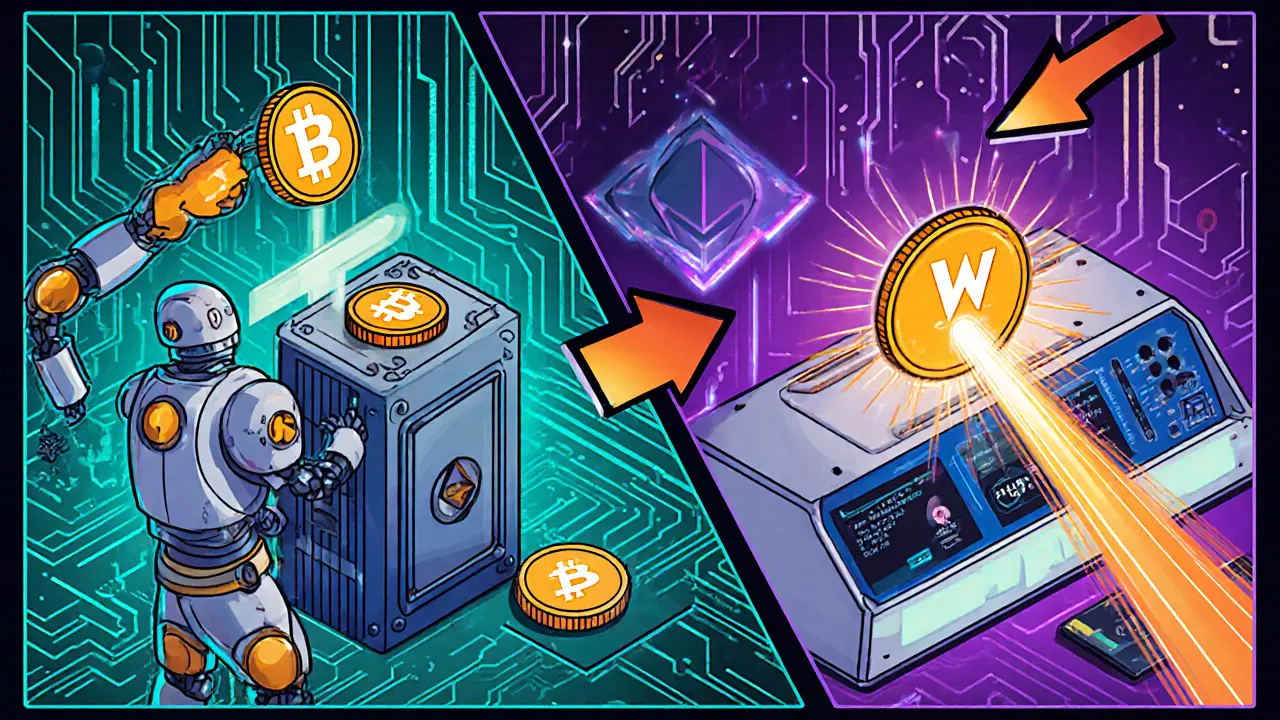Wrapped THETA (WTHETA) Explained: What It Is, How It Works, and Why It Matters
 Oct, 30 2024
Oct, 30 2024
Key Takeaways
- Wrapped THETA (WTHETA) is a 1:1 pegged version of the native THETA token designed for cross‑chain use.
- WTHETA lets Theta Network participate in DeFi, DEXs, and other blockchain ecosystems.
- The wrapping process locks THETA in a smart contract and mints the equivalent amount on another chain.
- Major partners such as Google, Samsung, and Binance back the network, boosting credibility.
- Security hinges on both the original Theta chain and the target chain, so audits matter.
What is Wrapped THETA (WTHETA)?
Wrapped THETA is a cryptocurrency that represents the native THETA token on external blockchain networks, maintaining a strict 1:1 peg. While THETA governs the Theta Network, WTHETA is the bridge that lets that governance token move freely across ecosystems like Ethereum, BSC, or Avalanche. The concept mirrors other wrapped assets such as Wrapped Bitcoin (WBTC) or Wrapped Ether (WETH), but its niche is the video‑streaming‑focused Theta ecosystem.
Why does Theta need a wrapped version?
The Theta Network was built as a decentralized video‑delivery platform. Its native token, THETA, powers governance and rewards for node operators. However, most DeFi protocols, decentralized exchanges, and liquidity pools live on chains that are not Theta’s own Layer‑1. By creating WTHETA, developers can lock THETA in a custodial smart contract, mint the same amount on, for example, Ethereum, and then use it in yield farms, lending platforms, or as collateral.
How does the wrapping process work?
- A user sends THETA to a designated smart contract on the Theta blockchain.
- The contract records the amount and locks the tokens, making them unspendable on the native chain.
- Simultaneously, a minting contract on the target chain (e.g., Ethereum) creates an equivalent amount of WTHETA.
- The user receives WTHETA on the target chain and can trade, stake, or lend it there.
- To unwrap, the user sends WTHETA back to the minting contract, which burns the wrapped tokens and releases the original THETA from the lock‑up contract.
This two‑step mechanism preserves the 1:1 peg while ensuring that the total supply of THETA never changes.

Technical backbone of the Theta ecosystem
Understanding WTHETA also means grasping the three core components of Theta:
- Theta Blockchain is an EVM‑compatible Layer‑1 chain that hosts the native THETA token and the smart contracts governing the network.
- Theta Metachain connects the main chain with unlimited specialized side‑chains, enabling horizontal scaling and sub‑second finality.
- Theta Edge Network is a decentralized cloud of more than 10,000 active nodes delivering over 80 petaFLOPS of GPU power for video rendering and AI tasks.
These layers work together to solve the three pain points of traditional video streaming: centralization, high costs, and latency.
Tokenomics: THETA, TFUEL, and WTHETA
Theta uses a dual‑token model:
- THETA: a governance token. Holders vote on protocol upgrades, validator selections, and network parameters.
- TFUEL: the operational token that pays for bandwidth and computing resources on the Edge Network.
- WTHETA: the wrapped representation of THETA, primarily for cross‑chain liquidity.
The separation keeps the governance token’s price relatively stable while TFUEL reflects network usage. When you lock THETA to mint WTHETA, you temporarily reduce circulating THETA, which can create slight scarcity effects-though the impact is usually marginal given the overall supply.
Interoperability and DeFi opportunities
Because WTHETA lives on popular smart‑contract platforms, developers can embed it in any DeFi protocol that supports ERC‑20‑style tokens. Common use cases include:
- Providing liquidity on AMMs (e.g., Uniswap, SushiSwap) to earn fees.
- Using WTHETA as collateral for borrowing stablecoins.
- Participating in yield farms that reward users with TFUEL or other tokens.
- Staking WTHETA on cross‑chain staking platforms that offer higher APYs than native staking.
These options turn a governance token into a revenue‑generating asset without sacrificing voting power-users simply hold THETA on the native chain for governance while their WTHETA works in DeFi.
How to acquire Wrapped THETA
The simplest way for retail users is through major exchanges that list WTHETA, such as Binance. Binance’s Web3 Wallet guides users to connect a crypto wallet (MetaMask, Trust Wallet, etc.) and then swap THETA for WTHETA on a decentralized exchange.
Steps on Binance (as of March 2024):
- Log in to your Binance account and open the Web3 Wallet.
- Select “Connect Wallet” and choose your preferred crypto wallet.
- Navigate to the “Swap” tab, choose THETA as the source asset and WTHETA as the target.
- Enter the amount, review the 1:1 peg guarantee, and confirm the transaction.
- Once the transaction is mined, WTHETA appears in your wallet on the selected chain (e.g., Ethereum).
Alternative routes include using decentralized bridges like AnySwap or Wormhole, which also lock THETA on the source chain and mint WTHETA on the destination chain.

Security considerations
Wrapped tokens inherit security features from both the original chain and the target chain. For WTHETA, that means:
- THETA’s consensus and validator set (including Google, Binance, Samsung) protect the lock‑up contract.
- The target chain’s smart‑contract audit (e.g., Ethereum) must ensure the minting/burning contracts are free from re‑entrancy bugs.
- Bridge operators hold custodial authority; any compromise could lead to loss of the locked THETA.
So far, no major security incidents have been reported for WTHETA, but users should stay on reputable bridges and keep contracts audited.
Future outlook and market positioning
Theta’s partnerships with tech giants-Google Cloud for edge computing, Samsung for hardware integration, and Binance for liquidity-signal strong institutional confidence. The network’s EVM compatibility lowers the entry barrier for developers, meaning new dApps can launch quickly using existing Solidity tooling.
Price forecasts vary widely. Changelly projects an average THETA price of $615 by 2050, while Coinbase’s more conservative model predicts WTHETA around $0.60 in 2026. The disparity underscores the speculative nature of crypto valuation.
Looking ahead, Theta aims to expand its Edge Network for AI‑driven video rendering, a move that could drive TFUEL demand and indirectly boost THETA’s utility. As the video‑streaming market is projected to exceed $180 billion by 2027, Theta’s decentralized approach may capture a niche of cost‑sensitive creators and platforms.
Comparison: Wrapped THETA vs Native THETA
| Attribute | THETA (native) | Wrapped THETA (WTHETA) |
|---|---|---|
| Symbol | THETA | WTHETA |
| Primary purpose | Governance & validator rewards | Cross‑chain liquidity & DeFi integration |
| Chain location | Theta Blockchain (native Layer‑1) | Minted on external chains (Ethereum, BSC, etc.) |
| Peg mechanism | Intrinsic token | 1:1 lock‑mint ratio via smart contract |
| Typical use cases | Voting, validator staking | Yield farming, collateral, swaps |
Frequently Asked Questions
What is the main difference between THETA and WTHETA?
THETA is the native governance token on the Theta blockchain. WTHETA is a wrapped version that lives on other chains, enabling DeFi actions while keeping a 1:1 peg to THETA.
How can I unwrap WTHETA back to THETA?
Send your WTHETA to the designated burn contract on the target chain. The contract destroys the wrapped tokens and releases the equivalent amount of native THETA from the lock‑up contract on the Theta network.
Is WTHETA safe to hold on Ethereum?
Safety depends on the security of both the Theta lock‑up contract and the Ethereum mint/burn contracts. Use reputable bridges and keep contracts audited; also store tokens in hardware wallets when possible.
Can I stake WTHETA for rewards?
Direct staking of WTHETA on the native Theta network isn’t possible. However, many DeFi platforms let you stake WTHETA for token rewards, often at higher APYs than native staking.
Where is WTHETA listed?
Binance lists WTHETA and provides a Web3 Wallet bridge. It also appears on decentralized exchanges like Uniswap (Ethereum) and PancakeSwap (BSC) via various cross‑chain bridges.
Paul Kotze
October 24, 2025 AT 03:06Jason Roland
October 24, 2025 AT 15:20Niki Burandt
October 24, 2025 AT 18:42Chris Pratt
October 25, 2025 AT 04:34Karen Donahue
October 25, 2025 AT 21:48Bert Martin
October 26, 2025 AT 21:00